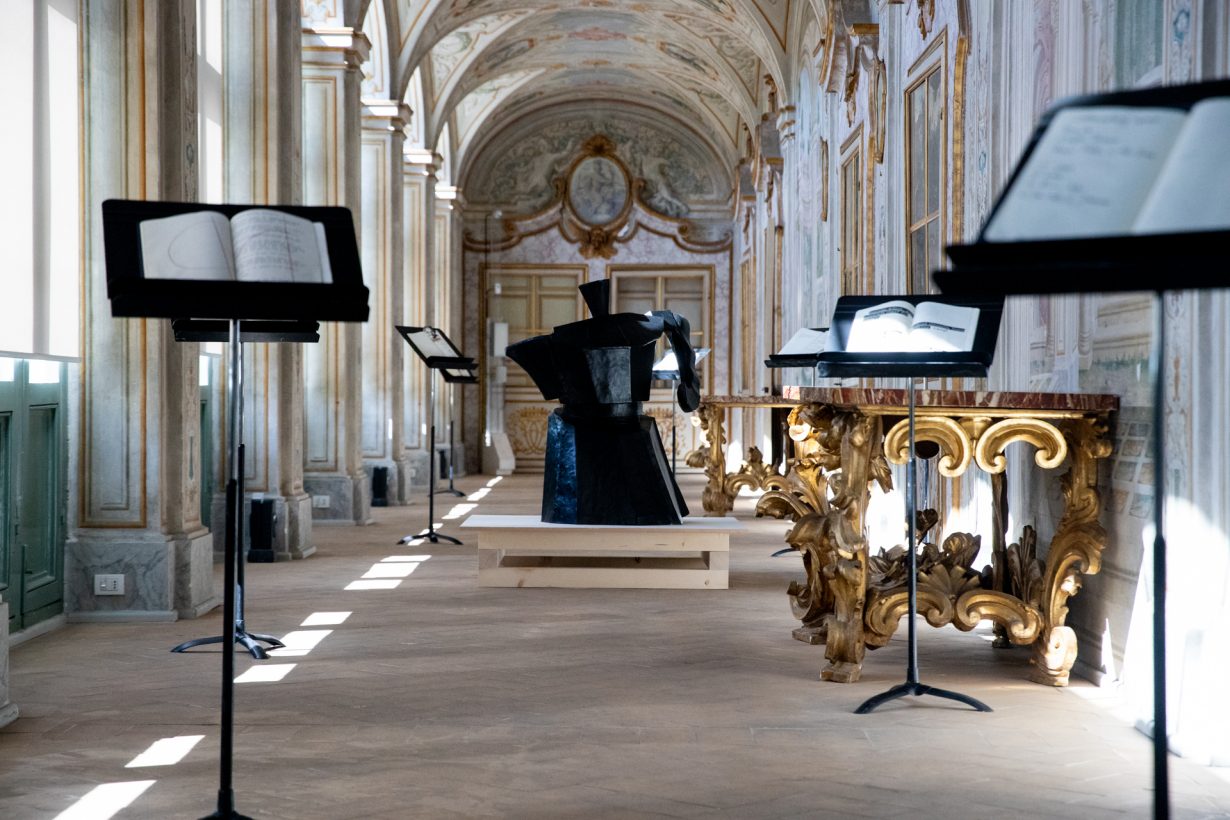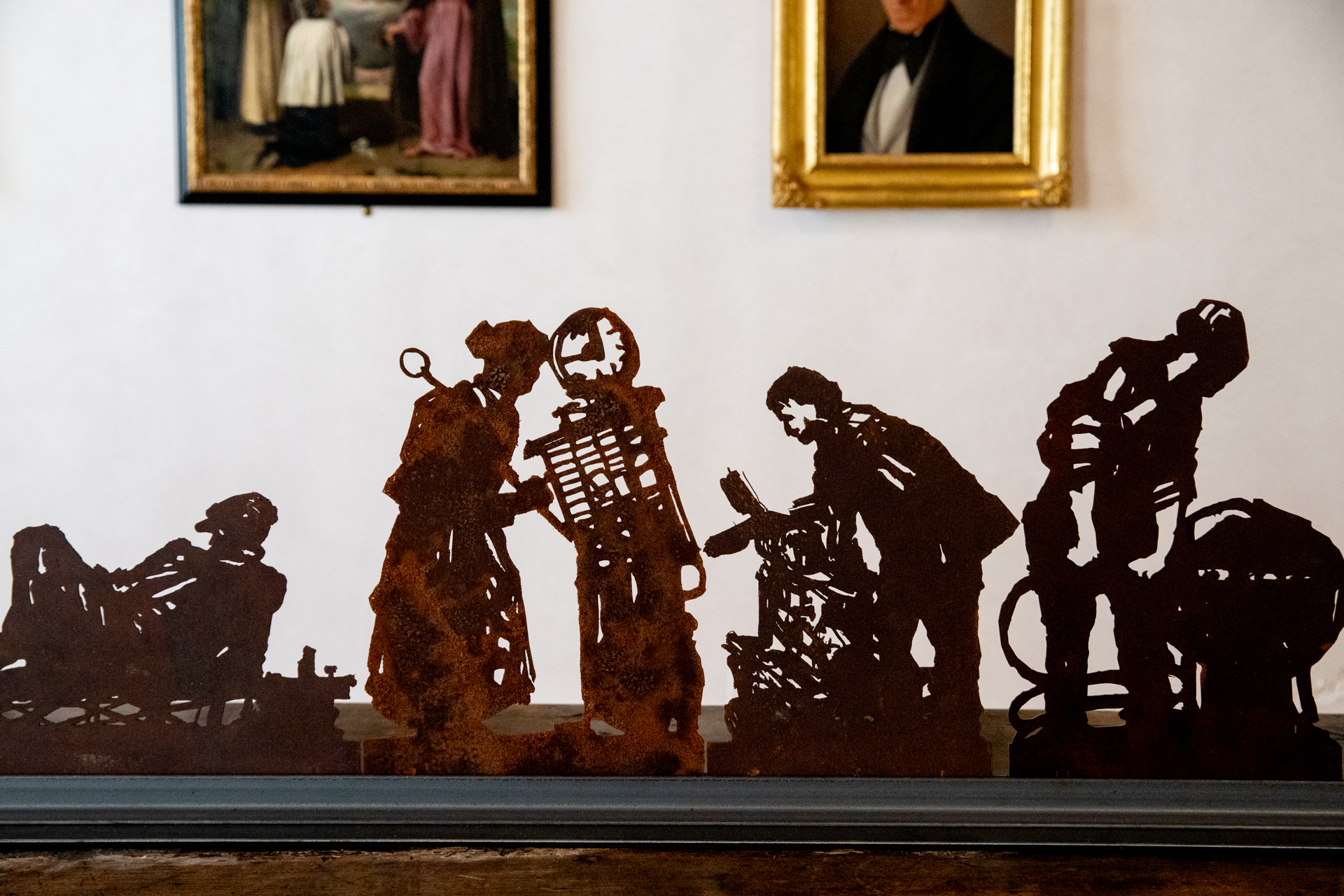This new survey is as much about Kentridge’s creative and conceptual process as about how we make sense of an increasingly polarised world
The first floor of the eighteenth-century Palazzo Collicola presents a curatorial challenge. The rooms are heavy with the history of the noble Umbrian family whose countless paintings, portraits and precious belongings adorn this former residence, and nothing can be nailed or screwed to the walls and floors. Thus, William Kentridge’s series Blue Rubrics (2019) – framed works featuring maxims declared loudly in bright blue lapis lazuli watercolours, painted onto old logbook pages from the former Royal Observatory, Cape of Good Hope – is mounted on simple plywood stands, which face in multiple directions. The effect is captivating, lending a choral dimension to statements like To What End, God’s Opinion is Unknown or, my favourite, Let us try for once not to be right. To the left is the bronze sculpture Apron (2021), a surreal anthropomorphic apron-wearing megaphone painted black. Together, they set the stage for an exhibition spanning the prolific South African artist’s last two decades: drawings, animations, prints, sculptures, tapestries and notebooks. It is as much about Kentridge’s creative and conceptual process as about how we make sense of an increasingly polarised world.
Nowhere is this more evident than in the centrepiece video Fugitive Words (2024). Scored to Beethoven’s Piano Trio, Op 97 (1811), it guides us through the artist’s mind at work, by way of his studio notebook of charcoal drawings, collages and notes. Kentridge’s animation technique is immediately recognisable, and hypnotic. In succession, surrounded by his worktable’s range of charcoal sticks, pencils, triangular rulers and scissors, single images are drawn and redrawn – a tree unfurling from a chopped tree trunk, charcoal dust turning into tiny birds that fly across his notebook and beyond, scribbly fragments transforming into maps and landscapes. Erasure is integral here, resulting in a slow process indeed; a minute of animation typically takes the artist several weeks to complete. Charcoal, relatedly, is essential too: easily rubbed off, it can be quickly altered, reflecting the speed and provisionality of thinking, but also the past that always leaves a trace. The inherent messiness that is a trademark of Kentridge’s animations is clearly a disavowal of all notions of ‘truth’ and ‘purity’ often wielded by authoritarians.

Throughout the show, we see Kentridge’s interest in cross-fertilising mediums, from sculpture to opera – the artist was in town for Spoleto’s annual Festival dei Due Mondi with his chamber opera The Great Yes, The Great No (2024) – and range of references. The nose has been a signature Kentridge theme since his 2010 opera production The Nose, inspired in part by Nikolai Gogol’s 1836 satirical short story, and Shostakovich’s 1930 operatic version, about a man’s attempts to find his missing snout. In Untitled VIII (Nose on horseback) (2007), the pompous nose assumes an absurd Napoleonesque stance astride a horse, the monumentality of his pose undercut by the sculpture’s small (82 cm high) dimensions in a brilliantly simple evisceration of authoritarian aspirations. Elsewhere, faithful printed replicas of 30 of Kentridge’s notebooks are displayed throughout the gallery floor, propped open on music stands so viewers can browse (Studio Notebooks [History on One Leg], 2024). They are repositories of everything: poems by favourite authors, measurements of works or sets, recordings of events or thoughts, drawings, sketches, collages. Together, they demonstrate how we make sense of the world through the metaphorical collages that make up our lives: our own histories, memories, prejudices, readings, headlines, conversations. In a time when everyone appears steadfast in speaking their ‘truths’, Kentridge’s work continues, wholly refreshingly, to refuse didacticism, reminding us that so much of what is presented as objective is in fact quite the opposite.
Pensieri Fuggitivi (Fugitive Thoughts) at Palazzo Collicola, Spoleto, through 2 November
From the October 2025 issue of ArtReview – get your copy.
